#Vladimir Ovchinnikov
Text
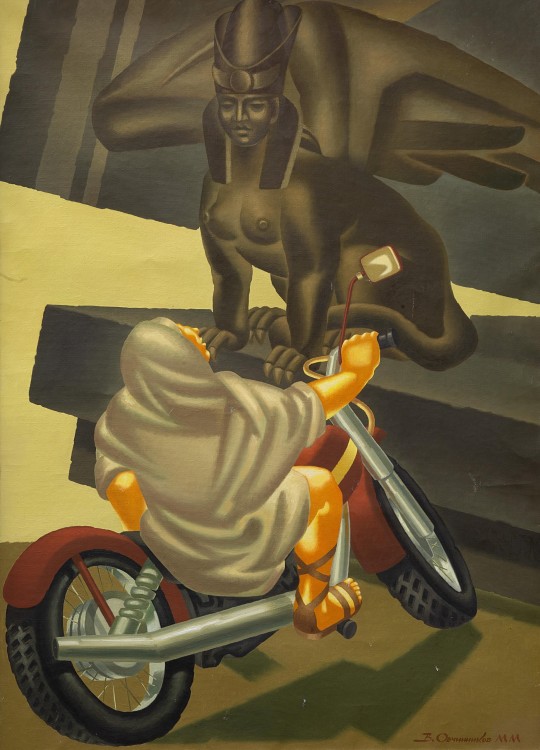
Vladimir Ovchinnikov (1941-2015) — Oedipus and Sphinx [oil, canvas, 2000]
206 notes
·
View notes
Photo

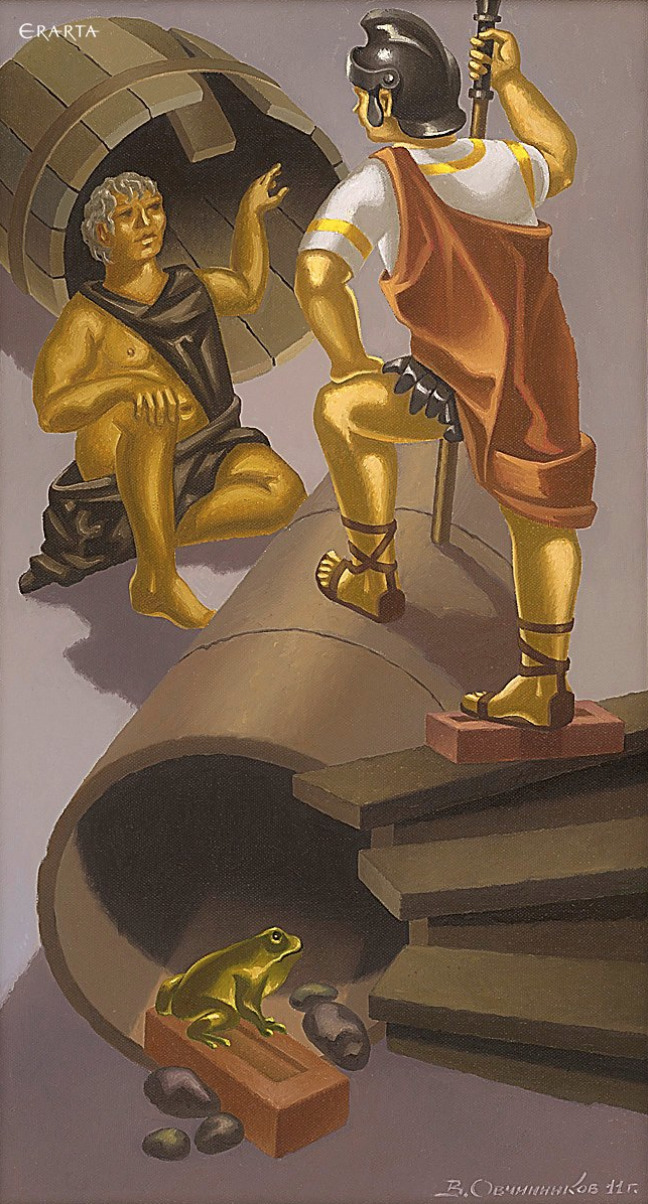
Diogenes (1979) & Alexander and Diogenes (2011) by Vladimir Ovchinnikov
I like to think that, I don't know if I have any answers, I don't know if we ever do, but I'd like to think of my journey as a man, and a performer and an artist, tradesperson that all of that time spent, and still being spent contemplating spiritual things has made me over the years more at peace with myself and more confident onstage, more confident just in general. I would hesitate to say that I have found the Holy Grail.
—Live's Ed Kowalczyk Reflects on 25 Years of 'Throwing Copper'
See also The Twelve Senses, Forces & World Views
#Vladimir Ovchinnikov#Diogenes#Alexander the Great#Gemini#Virgo#Capricorn#Ed Kowalczyk#LIVE#Throwing Copper#The Holy Grail#anthroposophy#spiritual science
5 notes
·
View notes
Text
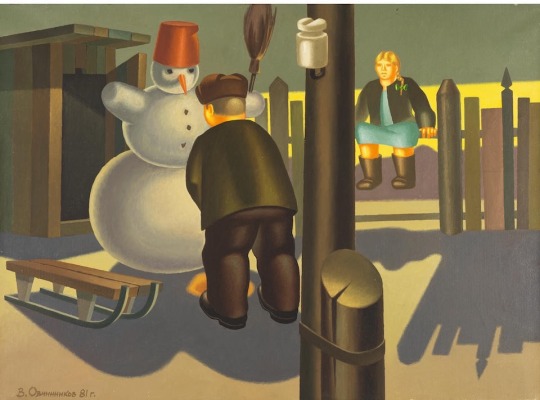
Vladimir Ovchinnikov (Russian, 1941-2015)
L'hiver à Chouvalovo/ Winter in Shuvalovo
Signé en cyrillique et daté "81" (en bas à gauche) ; encore signé, titré et daté (verso)
Huile sur toile
Bonhams
26 notes
·
View notes
Text

In a small Russian town, a pensioner's street art denounces Ukraine conflict
Despite heavy fines from the Russian government, Vladimir Ovchinnikov continues to condemn the Ukraine conflict through poignant murals.
0 notes
Text

Anatoliy Solonitsyn in Andrei Rublev (Andrei Tarkovsky, 1966)
Cast: Anatoliy Solonitsyn, Nikolay Grinko, Nikolay Sergeyev, Nikolay Burlyaev, Ivan Lapikov, Irma Raush, Yuriy Nazarov, Yuriy Nikilin, Rolan Bykov, Mikhail Kononov. Screenplay: Andrey Konchalovskiy, Andrei Tarkovsky. Cinematography: Vadim Yusov. Production design: Evgeniy Chernyaev. Film editing: Tatyana Egorycheva, Lyudmila Feyginova, Olga Shevkunenko. Music: Vyacheslav Ovchinnikov.
Has any filmmaker ever made more eloquent use of the widescreen format than Andrei Tarkovsky does in Andrei Rublev? It was a process developed by Hollywood to help win its war with television -- bigger naturally assumed to be better. In Hollywood, it usually went hand-in-hand with color, and although the various widescreen processes -- Cinerama, Cinemascope, VistaVision, etc. -- were used in black-and-white films, they often feel out of place today. A case in point: The Diary of Anne Frank (George Stevens, 1959), which won an Oscar for the cinematography of William C. Mellor, but which seems to cry out for a format less expansive than CinemaScope, in which the Frank family's attic loses its cramped and confined essence. Andrei Rublev was filmed in a process called Sovscope, which like CinemaScope used anamorphic lenses to produce a 2.35:1 aspect ratio. Tarkovsky and cinematographer Vadim Yusov artfully work with the expanse of the screen, not shying away from closeups but also doing extraordinary movement with the camera. One of the earliest scenes takes place in the barn in which Rublev and his fellow artist-monks take shelter from the rain. We are given an astonishing 360-degree pan inside the barn, circling from the monks to the other denizens of the shelter and back to the monks, a study in faces that establishes one of the film's major subjects: the nature of Russian humanity, which also becomes an abiding concern of Rublev's. (I think there's a witty acknowledgment of the nature of widescreen in that the peep-hole cut into the wall of the bar seems to have the same aspect ratio as the film.) And in the concluding sequence, there is a magnificent pan from the gates of the walled city of Vladimir below and the emerging procession up to the structure that holds the newly cast bell, where Boriska (Nikolay Burlyaev) waits anxiously. Andrei Rublev is one of those films I can't help rewatching; even though (or perhaps because) it's slow and challenging, it more than repays frequent viewings. Tarkovsky is not a director to be taken lightly, and the moment you begin to be lulled by the magnificence of Yusov's cinematography or Vyacheslav Ovchinnikov's score, the director is likely to shock you with images of cruelty and brutality but also of beauty that make you sit upright. A "trigger warning" might be especially needed for lovers of animals, given the harshness with which they are occasionally treated: There is a scene with a cow on fire that will likely haunt me for a long time.* But all the unpleasantness in the film is in service of a story about the persistence of the Russian people and the transcendence of art. Anatoliy Solonitsyn, who plays Rublev, looks a bit like Viggo Mortensen, and recalls for me the tormented masculinity you find in some of Mortensen's performances. Another standout performance is given by Tarkovsky's wife, billed as Irma Raush, as the "holy fool" Durochka, whom Rublev saves from a massacre by the Tatars by killing the assailant -- leading Rublev to atone by giving up his painting and taking a vow of silence. The last section of the film is given over to young Boriska, played by Nikolay Burlyaev, the astonishing Ivan in Tarkovsky's Ivan's Childhood (1962), who takes on the task of casting a church bell despite the suggestion that he will be murdered by the tyrannical Grand Duke (Yuriy Nazarov) if he fails. Although the film is in black-and-white, it concludes with a breathtaking color sequence in which Rublev's paintings are shown in close-up. To my mind, this final ecstatic survey of Rublev's work is the only section in which Tarkovsky is thwarted by the widescreen process: Rublev's paintings had an aspiring verticality that is at odds with the dimensions of the screen.
*The scene, I learned, on a recent re-viewing of the film, doesn't exist in all versions. In addition to versions made by Soviet censors, Tarkovsky himself made two: His original version ran 205 minutes, but he also made a "final cut" that runs 183 minutes.
1 note
·
View note
Photo

Vladimir Ovchinnikov (1941-2015) — The Fall of Icarus [oil on canvas, 1992]
1 note
·
View note
Text
War between Ukraine and Russia: Latest news live | kyiv denounces that 8,600 Ukrainian children have been forcibly deported to Russian territory
War between Ukraine and Russia: Latest news live | kyiv denounces that 8,600 Ukrainian children have been forcibly deported to Russian territory
The Russian retiree who denounces the war in Ukraine through urban art
For 20 years, Russian retiree Vladimir Ovchinnikov became famous for his murals of Stalinist-era repression painted on the streets of the small town of Borovsk, about 115 kilometers southwest of Moscow. Just over a month after Russia invaded Ukraine, Ovchchik changed the subject for his new work, a job that put his freedom in…
View On WordPress
0 notes
Text
"Banksy of Borovsk," a Russian muralist, is waging his own war
“Banksy of Borovsk,” a Russian muralist, is waging his own war
An 84-year-old artist was standing in front of one of the many murals he has painted in his provincial hometown the other day when a group of young women walked by. They’d traveled some 60 miles from Moscow just to see his latest work, and they giggled at the encounter.
“This is so cool,” said one. “You are the main attraction of the city.”
Artist Vladimir A. Ovchinnikov has long covered the…
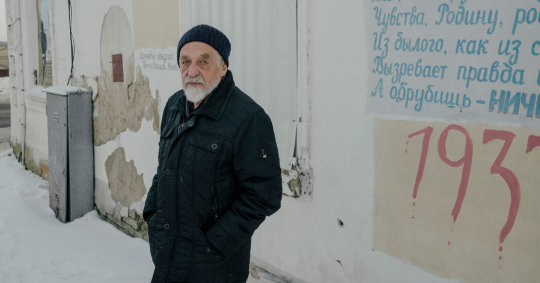
View On WordPress
0 notes
Text
In a Small Russian Town, a Pensioner's Street Art Denounces Ukraine Conflict : Inside US
In a Small Russian Town, a Pensioner’s Street Art Denounces Ukraine Conflict : Inside US
BOROVSK, Russia (Reuters) – Over 20 years, Russian pensioner Vladimir Ovchinnikov gained a following for his street murals in the small town of Borovsk, some 70 miles (115 km) southwest of Moscow, many of which depicted the plight of victims of Stalinist-era repressions.
But on March 25, just over a month after Russia sent tens of thousands of troops into Ukraine, Ovchinnikov created a new work,…

View On WordPress
0 notes
Photo
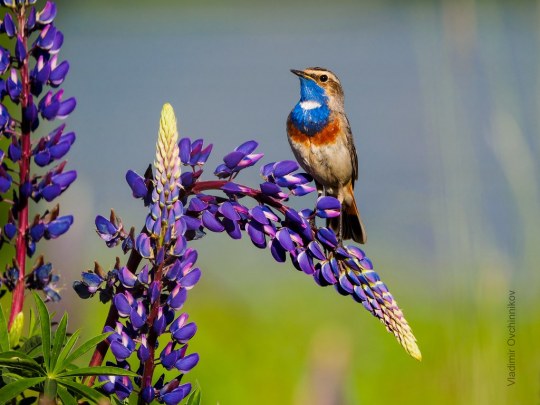
Bluethroat (Luscinia svecica)
© Vladimir Ovchinnikov
75 notes
·
View notes
Photo
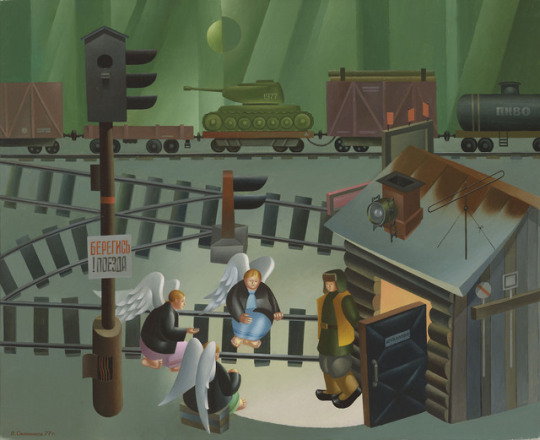
Vladimir Ovchinnikov (Russian, 1941-2015), Shuvalovo Station, 1977. Oil on canvas laid down on panel, 89.6 x 100.9 cm.
205 notes
·
View notes
Photo
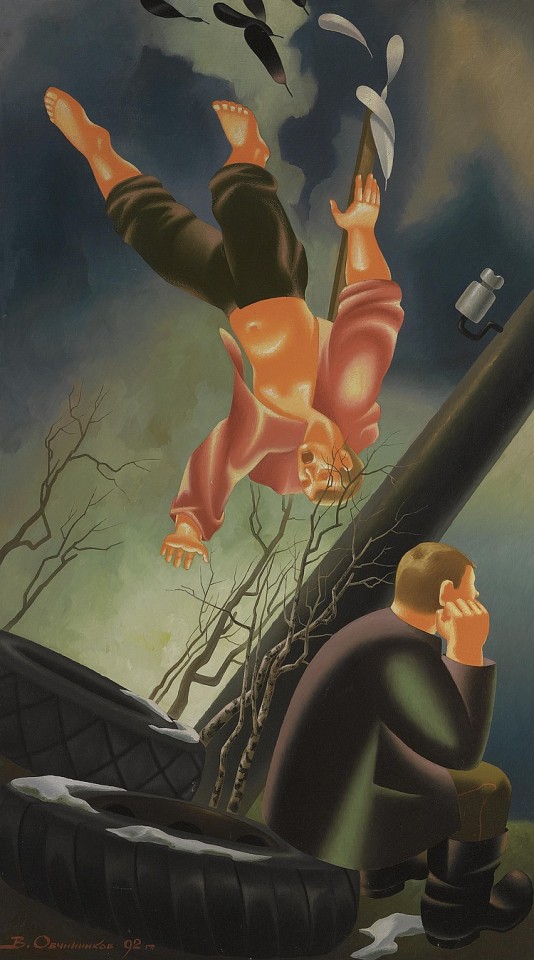
Vladimir Ovchinnikov (1941-2015) — The Fall of Icarus [oil on canvas, 1992]
204 notes
·
View notes
Photo
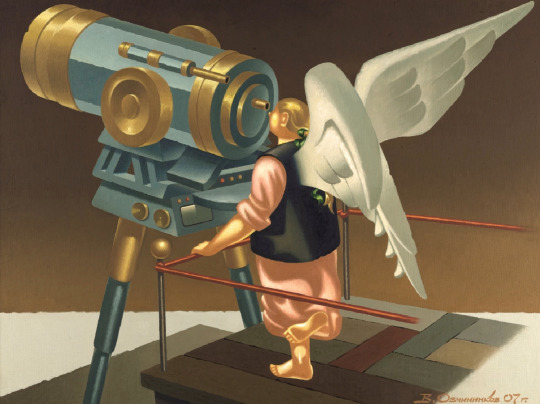
Angel at the Telescope (2007) by Vladimir Ovchinnikov
Looking for the indirect route by which the Archangels guided humanity by working with the Angels during the fourth post-Atlantean age, we can say: This was done via the human blood. And the social structure was also created via the blood, for it was based on blood relationship, on blood bonds. Both the Archangels and the Angels had their dwelling place in the blood, as it were. Truly, the blood is not merely something for chemists to analyse; it is also the dwelling place of entities from higher worlds.
During the fourth post-Atlantean age, therefore, the blood was the dwelling place of Archangels and Angels. This is changing with the fifth post-Atlantean age, for the Angels—I am referring to the Angels of Light, the normal Angels—will take possession more of the blood, and the Archangels will be more involved in the nervous system. This is putting it in the terms of the modern science of physiology. Using an older terminology I might also say: during the fifth post-Atlantean age the Archangels are essentially more at work in the brain and the Angels in the heart. You see, therefore, that a major change has occurred which can be traced all the way to the physical structure of human beings.
—Rudolf Steiner, The Fall of the Spirits of Darkness: Lecture XIV
0 notes
Text
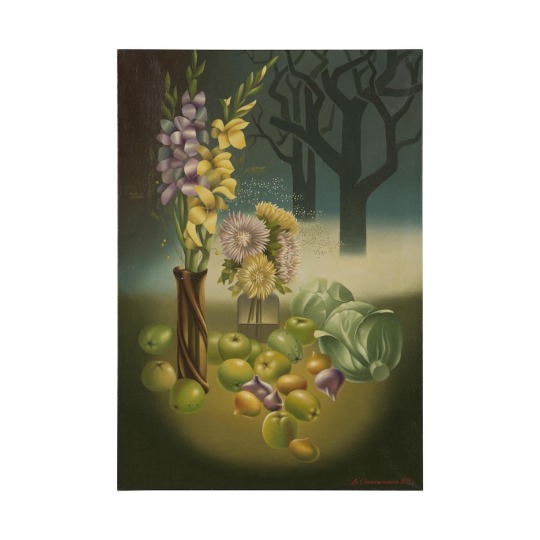
Vladimir Ovchinnikov (Russian, 1941-2015)
Grande nature morte d'automne / Large Autumn Still life
Signé en cyrillique et daté « 82 » (en bas à droite) ; en outre signé, daté et titré (verso)
Huile sur toile
Bonhams
5 notes
·
View notes
Photo

VLADIMIR OVCHINNIKOV Lighthouse on the hill.1958
oil on canvas, 44,5 x 85
10 notes
·
View notes
Text
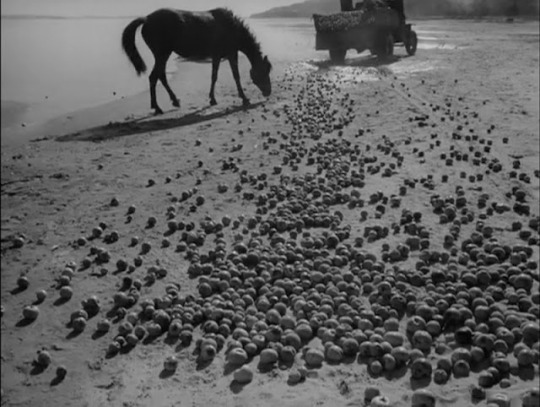
Ivan's Childhood (Andrei Tarkovsky, 1962)
Cast: Nikolay Burlyaev, Valentin Zubkov, Evgeniy Zharikov, Stepan Krylov, Nikolay Grinko, Dmitri Milyutenko, Valentina Malyavina, Irina Tarkovskaya, Andrey Konchalovskiy. Screenplay: Vladimir Bogomolov, Mikhail Papava, based on a story by Vladimir Bogomolov. Vadim Yusov. Production design: Evgeniy Chernyaev. Film editing: Lyudmila Feyginova. Music: Vyacheslav Ovchinnikov.
There are scenes in Ivan's Childhood that would work in the hands of only Andrei Tarkovsky. The famous scene in the birch forest, in which Kholin (Valentin Zubkov) straddles a trench and kisses Masha (Valentina Malyavina) while dangling her over it is completely extraneous to Ivan's story, as are almost all the scenes in which Masha, the physician's assistant, appears. And Tarkovsky never falls into the trap of sentimentality in the dream sequences, including the film's ending. In fact, I think it's a mistake to call them "dream sequences" -- they mostly avoid the conventions of movie dreams like odd angles or camera tricks or surreal elements. They're really memory pieces, explorations of the other side of Ivan's childhood, the innocent years of peace, poetically interpolated into the harshness of war. In fact, the "real" sequences are often more dreamlike than the memories: the dizzying ghostlike trunks of the birch trees, the flares falling silently like meteorites, the spiky war ruins that threaten to impale. It's a heartbreaking film because Tarkovsky refuses to pull out all the melodramatic stops but lets his images speak for themselves and because Nikolay Burlyaev performs with such conviction as Ivan, in one of the greatest performances by a child ever captured on film. It's probably the most poetic war film ever made because the war recedes into the background as a thing remembered.
0 notes